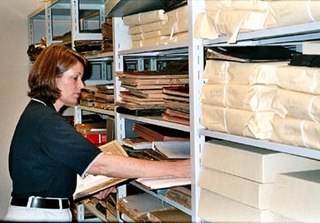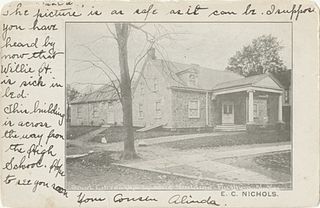
An archive is an accumulation of historical records or materials – in any medium – or the physical facility in which they are located.

Digitization is the process of converting information into a digital format. The result is the representation of an object, image, sound, document, or signal obtained by generating a series of numbers that describe a discrete set of points or samples. The result is called digital representation or, more specifically, a digital image, for the object, and digital form, for the signal. In modern practice, the digitized data is in the form of binary numbers, which facilitates processing by digital computers and other operations, but digitizing simply means "the conversion of analog source material into a numerical format"; the decimal or any other number system can be used instead.

An archivist is an information professional who assesses, collects, organizes, preserves, maintains control over, and provides access to records and archives determined to have long-term value. The records maintained by an archivist can consist of a variety of forms, including letters, diaries, logs, other personal documents, government documents, sound or picture recordings, digital files, or other physical objects.

The National Archives of Australia (NAA), formerly known as the Commonwealth Archives Office and Australian Archives, is an Australian Government agency that is the official repository for all federal government documents. It collects, preserves and provides public access to these documents, as well as other archival material related to Australia that the Archives judge ought to be preserved.
In library and archival science, digital preservation is a formal process to ensure that digital information of continuing value remains accessible and usable in the long term. It involves planning, resource allocation, and application of preservation methods and technologies, and combines policies, strategies and actions to ensure access to reformatted and "born-digital" content, regardless of the challenges of media failure and technological change. The goal of digital preservation is the accurate rendering of authenticated content over time.
Digital permanence addresses the history and development of digital storage techniques, specifically quantifying the expected lifetime of data stored on various digital media and the factors which influence the permanence of digital data. It is often a mix of ensuring the data itself can be retained on a particular form of media and that the technology remains viable. Where possible, as well as describing expected lifetimes, factors affecting data retention will be detailed, including potential technology issues.

Archival science, or archival studies, is the study and theory of building and curating archives, which are collections of documents, recordings, photographs and various other materials in physical or digital formats.
Web archiving is the process of collecting, preserving and providing access to material from the World Wide Web. The aim is to ensure that information is preserved in an archival format for research and the public.
Archival processing is the act of surveying, arranging, describing, and performing basic preservation activities on the recorded material of an individual, family, or organization after they are permanently transferred to an archive. A person engaging in this activity is known as an archival processor, archival technician, or archivist.

The Churchill Archives Centre (CAC) at Churchill College at the University of Cambridge is one of the largest repositories in the United Kingdom for the preservation and study of modern personal papers. It is best known for housing the papers of former British prime minister Winston Churchill.
The conservation and restoration of new media art is the study and practice of techniques for sustaining new media art created using from materials such as digital, biological, performative, and other variable media.
The Sophia Smith Collection at Smith College is an internationally recognized repository of manuscripts, photographs, periodicals and other primary sources in women's history.
Oral history preservation is the field that deals with the care and upkeep of oral history materials, whatever format they may be in. Oral history is a method of historical documentation, using interviews with living survivors of the time being investigated. Oral history often touches on topics scarcely touched on by written documents, and by doing so, fills in the gaps of records that make up early historical documents.
In archival science and archive administration, appraisal is a process usually conducted by members of the record-holding institution in which a body of records is examined to determine its value for that institution. It also involves determining how long this value will last. The activity is one of the central tasks of an archivist, to determine the archival value of specific records. When it occurs prior to acquisition, the appraisal process involves assessing records for inclusion in the archives. In connection with an institution's collecting policy, appraisal "represents a doorway into the archives through which all records must pass". Some considerations when conducting appraisal include how to meet the record-granting body's organizational needs, how to uphold requirements of organizational accountability, and how to meet the expectations of the record-using community.
Digital curation is the selection, preservation, maintenance, collection, and archiving of digital assets. Digital curation establishes, maintains, and adds value to repositories of digital data for present and future use. This is often accomplished by archivists, librarians, scientists, historians, and scholars. Enterprises are starting to use digital curation to improve the quality of information and data within their operational and strategic processes. Successful digital curation will mitigate digital obsolescence, keeping the information accessible to users indefinitely. Digital curation includes digital asset management, data curation, digital preservation, and electronic records management.

A digital library is an online database of digital objects that can include text, still images, audio, video, digital documents, or other digital media formats or a library accessible through the internet. Objects can consist of digitized content like print or photographs, as well as originally produced digital content like word processor files or social media posts. In addition to storing content, digital libraries provide means for organizing, searching, and retrieving the content contained in the collection. Digital libraries can vary immensely in size and scope, and can be maintained by individuals or organizations. The digital content may be stored locally, or accessed remotely via computer networks. These information retrieval systems are able to exchange information with each other through interoperability and sustainability.

Densho is a nonprofit organization based in Seattle, Washington whose mission is “to preserve and share history of the WWII incarceration of Japanese Americans to promote equity and justice today.” Densho collects video oral histories, photos, documents, and other primary source materials regarding Japanese American history, with a focus on the World War II period and the incarceration of Japanese Americans. Densho offers a free digital archive of these primary sources. It also maintains an online encyclopedia of notable Japanese Americans and related topics and an educational curricula.
A memory institution is an organization maintaining a repository of public knowledge, a generic term used about institutions such as libraries, archives, heritage institutions, aquaria and arboreta, and zoological and botanical gardens, as well as providers of digital libraries and data aggregation services which serve as memories for given societies or mankind. Memory institutions serve the purpose of documenting, contextualizing, preserving and indexing elements of human culture and collective memory. These institutions allow and enable society to better understand themselves, their past, and how the past impacts their future. These repositories are ultimately preservers of communities, languages, cultures, customs, tribes, and individuality. Memory institutions are repositories of knowledge, while also being actors of the transitions of knowledge and memory to the community. These institutions ultimately remain some form of collective memory. Increasingly such institutions are considered as a part of a unified documentation and information science perspective.

The Queens Memory Project is a community archiving program which aims to record and preserve contemporary history across the New York City borough of Queens. Community archives are created in response to needs defined by the members of a community, who may also exert control over how materials are used. The project is a collaborative effort between Queens College, City University of New York and Queens Public Library that was initially funded in 2010 through a grant from the Metropolitan New York Library Council (METRO). Materials in the archive are made accessible to the public through a website which contains oral history interviews and photographs documenting the lives of Queens residents. The stories and images are presented alongside digitized historical photographs, maps, news clippings and other archival records. The goal of the project is to allow visitors to the site to view otherwise scattered archival materials and personal stories in a searchable database of collective memory representing the borough of Queens.








